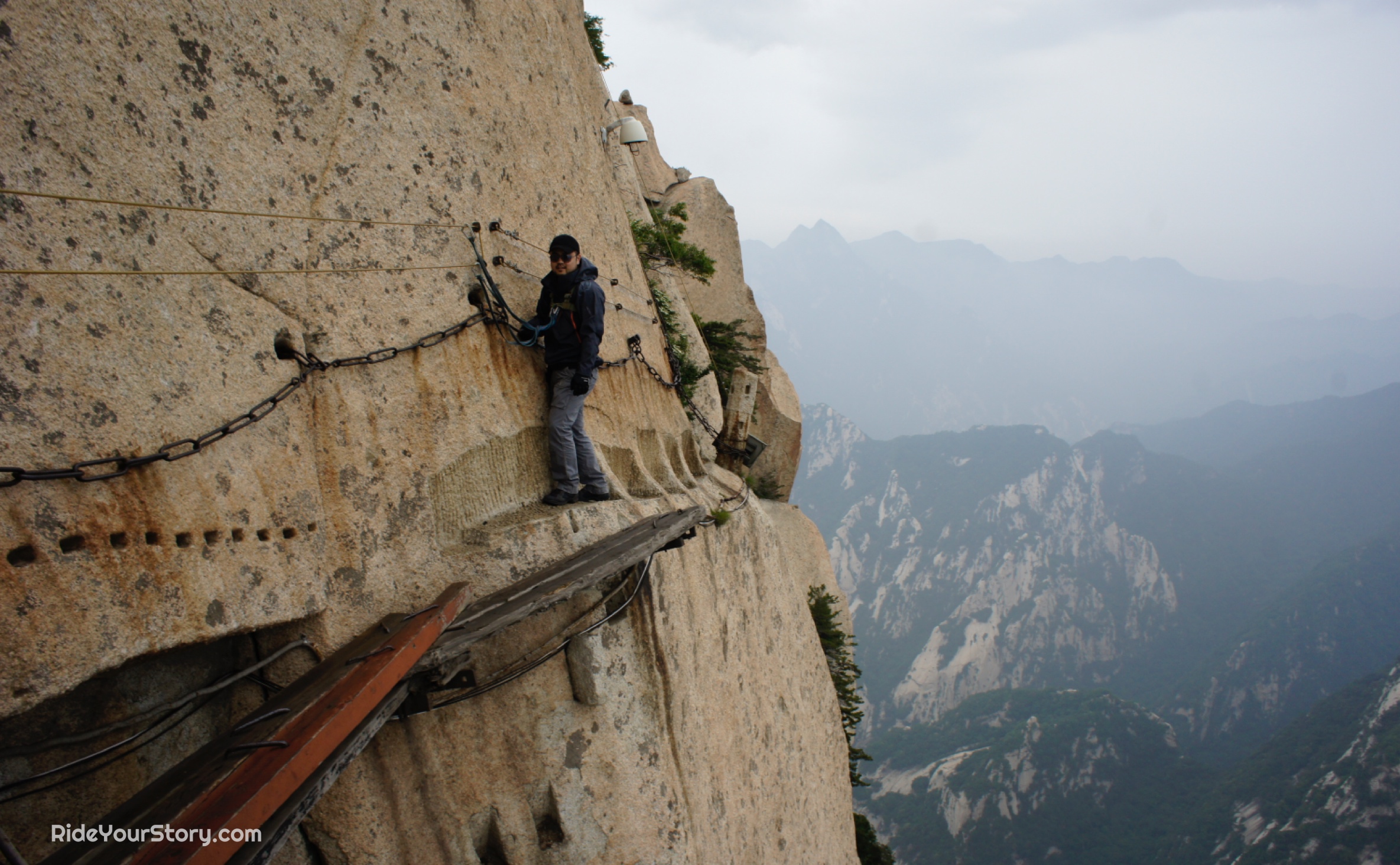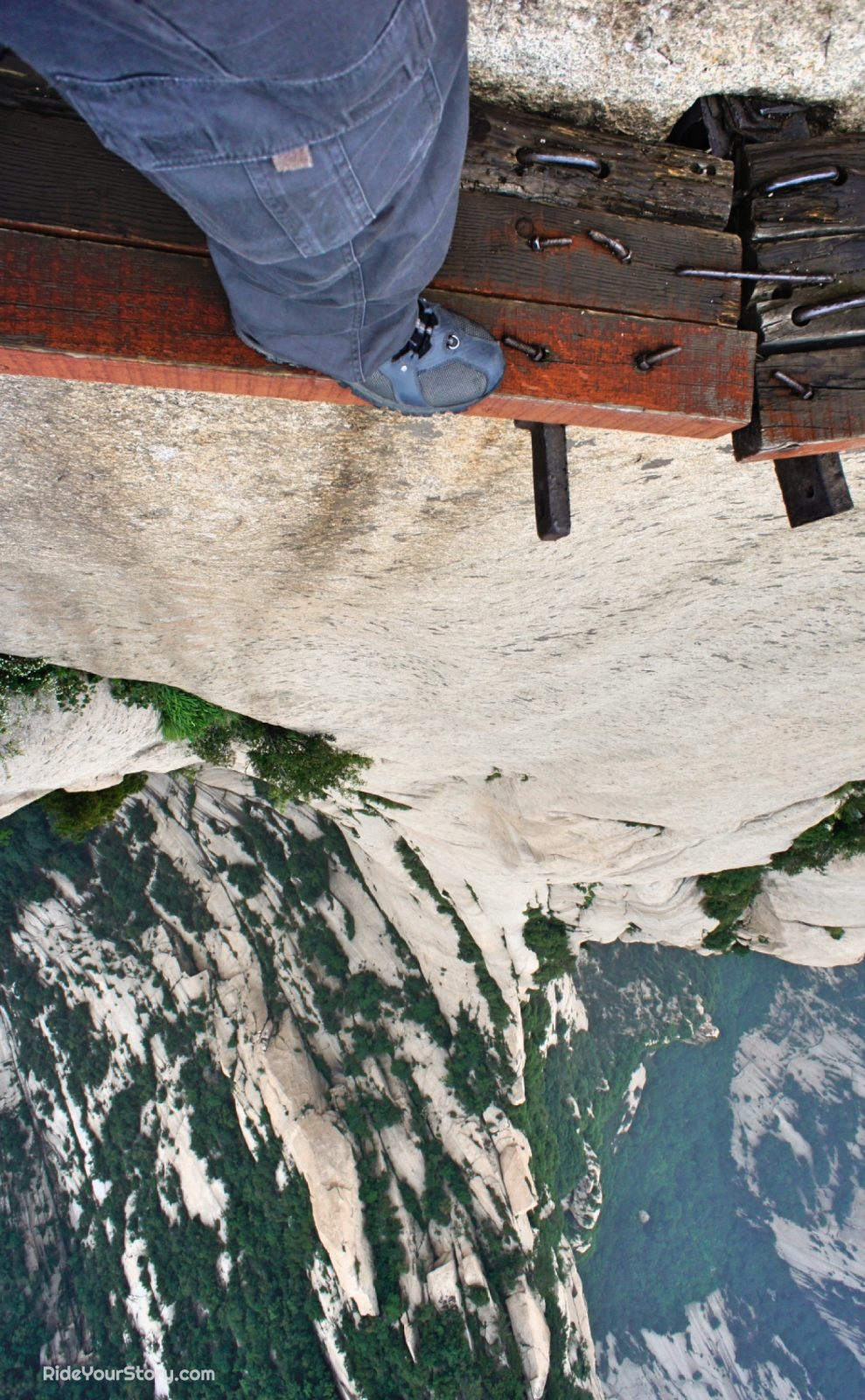
Skimming the surface of the South peak of Hua Shan, on a foot and half wide plank with a 2000 meter (1.2 miles) vertical drop. It is as dangerous as it look ?
As you are reading this, there will be probably a dozen of thrill seeker taking selfie at this very moment on this ‘most dangerous hike in the world‘. And hundreds have done it today. There is no short of Youtube videos with exaggerated reaction along the plank walk. So let me just write by recalling what captivate me to head to Hua Shan back in 2011, fulfilling my curious childhood dream – from a scene in an unknown documentary.
Yesteryear
Since the formation of People’s Republic of China (PRC) in 1949, by the Communist Party of China (CPC). China was closed to outsider until 1974. Even after then, hospitality infrastructure was lacking to cater to tourism. The toilets have no door and missing flushing system as a common story you hear from returning visitor. The minimum age requirement of 30 for a Singapore male to visit China then. A reason unexplained to me, but my guess is to prevent AWOL from our obligatory National Service. Many older generation have Chinese still have distance relatives back in China, so it wasn’t that difficult to. Hence our fascination of our own ‘ancestral motherland‘ is as elusive as the ‘Oriental‘ dream to a westerner. And our only channel to visit the ‘mainland’ (Dàlù /大陸) is documentary shown in theater. This was way before cable TV and color TV was a new thing if you have a high floor to run an antenna with, no Youtube nor Netflix. Betamax and VHS have not started their war.
I can’t recall twhat he rest of the documentary was about or the name of the title except for this particular scene of an old lady, probably in her 60s, clinging on and taking precise steps along the vertical surface of a mountain, making her annual pilgrimage to a cave at the other end. The scene was taken in black and while film, likely before Cultural Revolution as religious practice was scrutinized after that. That image of the old lady and that mountain was embedded in my mind since, without even me knowing the name of the mountain. I knew then that I had to visit this place one day. And though I did the hike back in 2011, I am still on the quest to recover that documentary. Free Solo with Alex Honnold was still second to me. But I am prepared for disappointment of the scene to be staged for dramatization, like most documentary. After all, it was intended to be the viral video of the time.
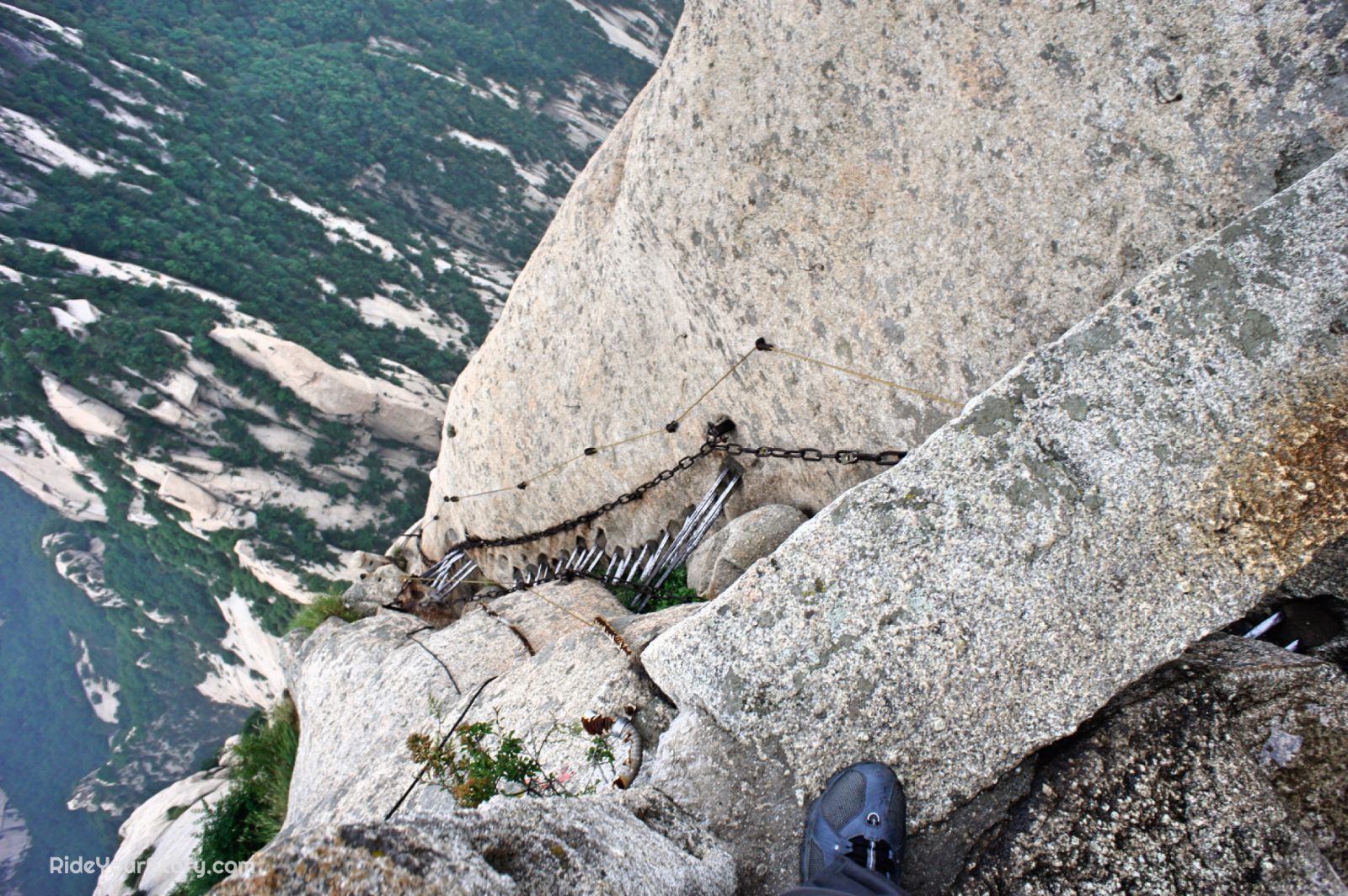
History
It is really not that difficult to imagine the fear of walking on a foot wide plank on a vertical height and drop of 2000m (I can’t verified this as some claim it to be 1000m>, I didn’t have an altimeter then). So I won’t re-enact it with an exaggerate facial expression and loud narrative. There are tons of these contaminating your timeline. Anyway, as mentioned, my hike was done back in 2011. That was way before social networking media degenerated into mindless stunts, challenges and memes. Opps millennials!
Instead I like to find out about the history – of the one who first paved that path. Why did he need to do it ? and How ? That is what mystified me!
And here are what I gathered…
Mount Hua was historically one of the center for Taoist (Daoist) practitioner in ancient China. At least until the rise the Communism in China, who forcibly expelled and forbid all religious practice. [I can keep going, but I will never stop and will deviated from the main topic, so let me leave a placeholder here for future post].
Among the practitioner was the first Head of Taoism in Huashan (华山派第一任掌门) – 贺志真 (Hè Zhìzhēn). Born in 1212, in 隆德 (present day 宁夏/Ningxia), he was a stone mason by trade (now that’ll explain!). 朝元洞 (Cháo Yuán cave) – a cave temple in HuaShan was believed to be built by him. He is also the founder. But the most astonishing of all is the 长空栈道 (also widely known as the ‘plank walk’).
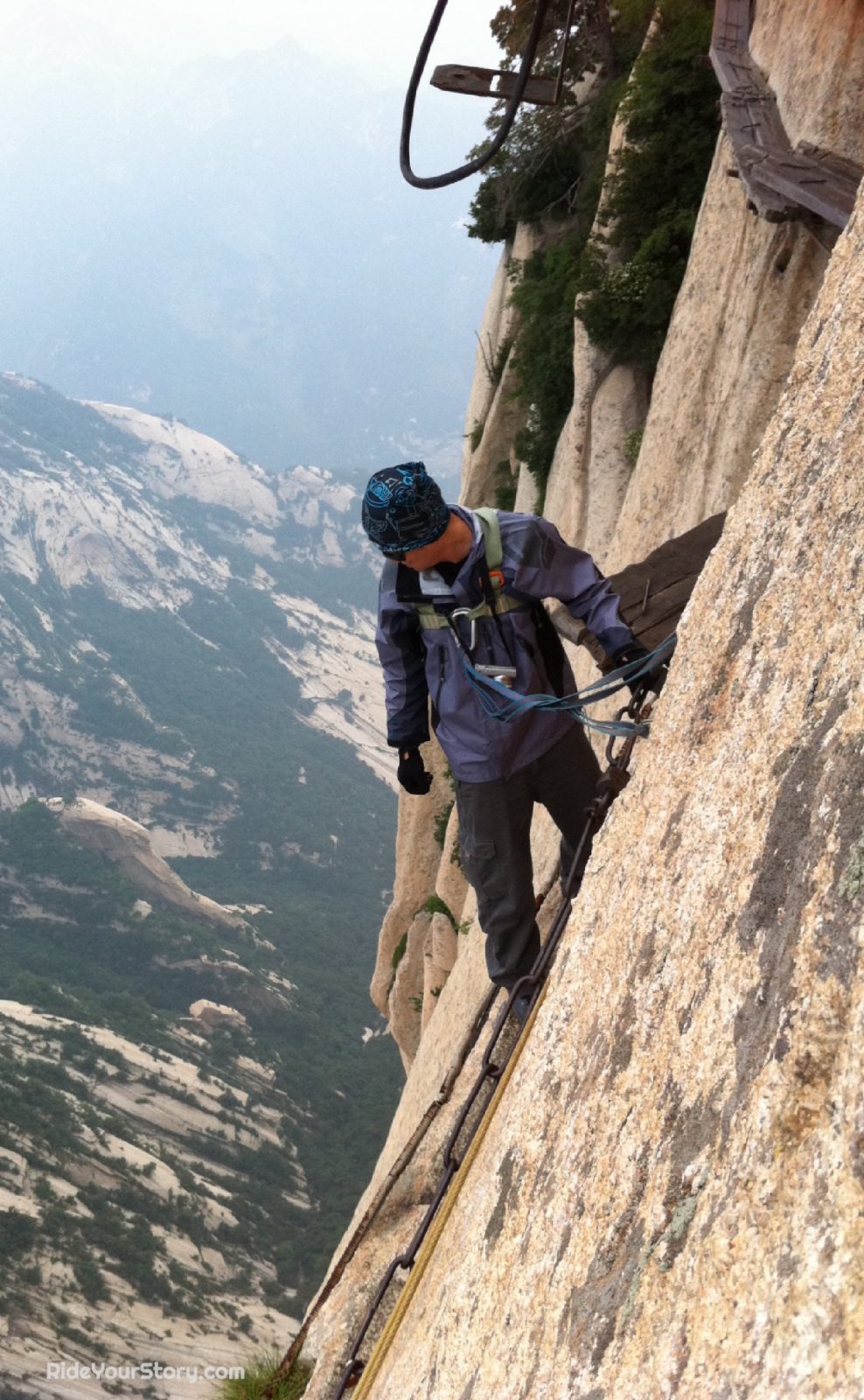
长空栈道
‘长空’ (cháng kōng) loosely translated as ‘Vast Sky’ and ‘栈道’ (zhàn dào) is a construction terms for a path on a cliff or face of mountain. Google translated it as ‘Plank’ and I believe that is where it get it’s name, and since wood plank are used for early building material. There are in face many other ‘栈道’ or plank walk throughout China. Though 长空栈道 in HuaShan will top the list for the least foothold and absent of balustrade.
The plank walk was built by Hè Zhìzhēn (贺志真) to reach his own meditation cave, self-isolation and retreat from the worldly distraction. He must have needed one badly and found this spot. Even among this remote mountain range in ancient time, he needed that one extreme solitude. How did he find this ? The only way to spot it is from the mountain on the other side. The cave are empty now, likely due to the catastrophe during the Cultural Revolution. But the plank walk is now a very popular tourist spot, overshadowing the actual purpose of his route. “There was nothing at the end.” – a tourist I met along the narrow walk told me, even when nobody asked.
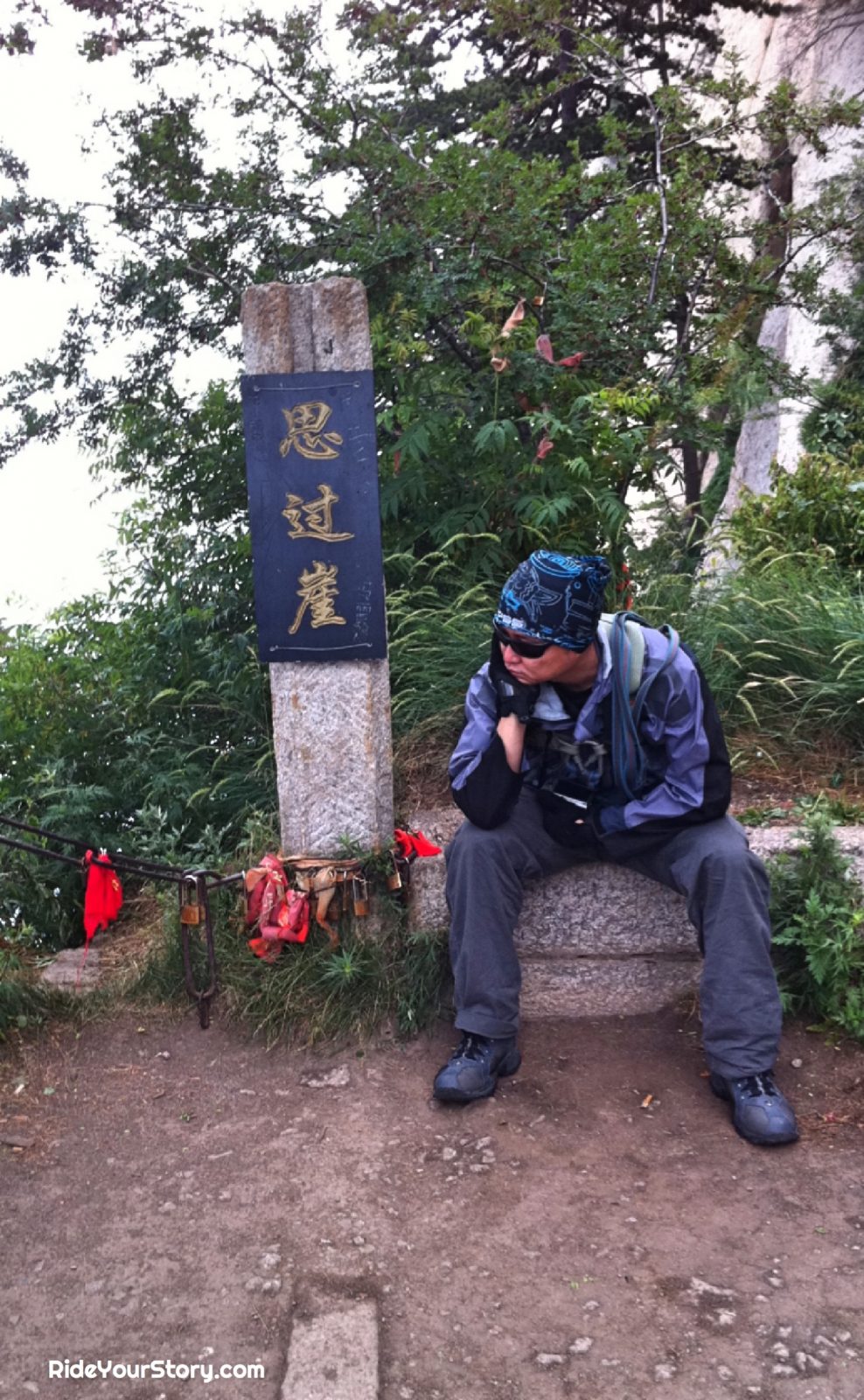
Just outside the meditation cave is a plaque – ‘思过崖’, meaning ‘Cliff of Contemplation‘. It is NOT part of any history of Hè Zhìzhēn’s meditation cave. So where did it come from ?
Jin Yong (金庸), a celebrated novelist who is largely responsible for the influence of Hong Kong’s wuxia (武侠/ martial arts) fantasy movie industry and lately the Hollywood blockbuster ‘Crouching Tiger, Hidden Dragon‘ (臥虎藏龍), catered to the western audience. Some claim he may have also influence George Lucas’s Star Wars franchise – the various clan, philosophical and swordsman warrior fighting for the justice in the wulin (武林/martial arts world). In some of Jinyong’s famous works – 射鵰英雄傳 (The Legend of the Condor Heroes) and 神鵰俠侶 (The Return of the Condor Heroes). HuaShan is a place where the best swordsman (武林高手) from the different fighting school and clan in the ancient China (within the novel, not historical) duel and exchange their moves, including flying, gravity defying wireless-fu and mountain leaping skill without wearing westernized underwear on the outside. 思过崖 was one of the location mentioned in his novel 笑傲江湖 (The Smiling, Proud Wanderer). But it was never specifically located and non-existent in real world. Without guessing, it has to be a brilliant good idea of a care-taking official to rename and entice tourist to this spot and fool history. Just like many other renamed location you can find in touristy China, if you can spot it. Avatar Hallelujah Mountains anyone? And good coaxing job they did, it was pick as a suicide spot for a lost soul back in 2018 (and likely more earlier) with a long way down with ample time for contemplation.
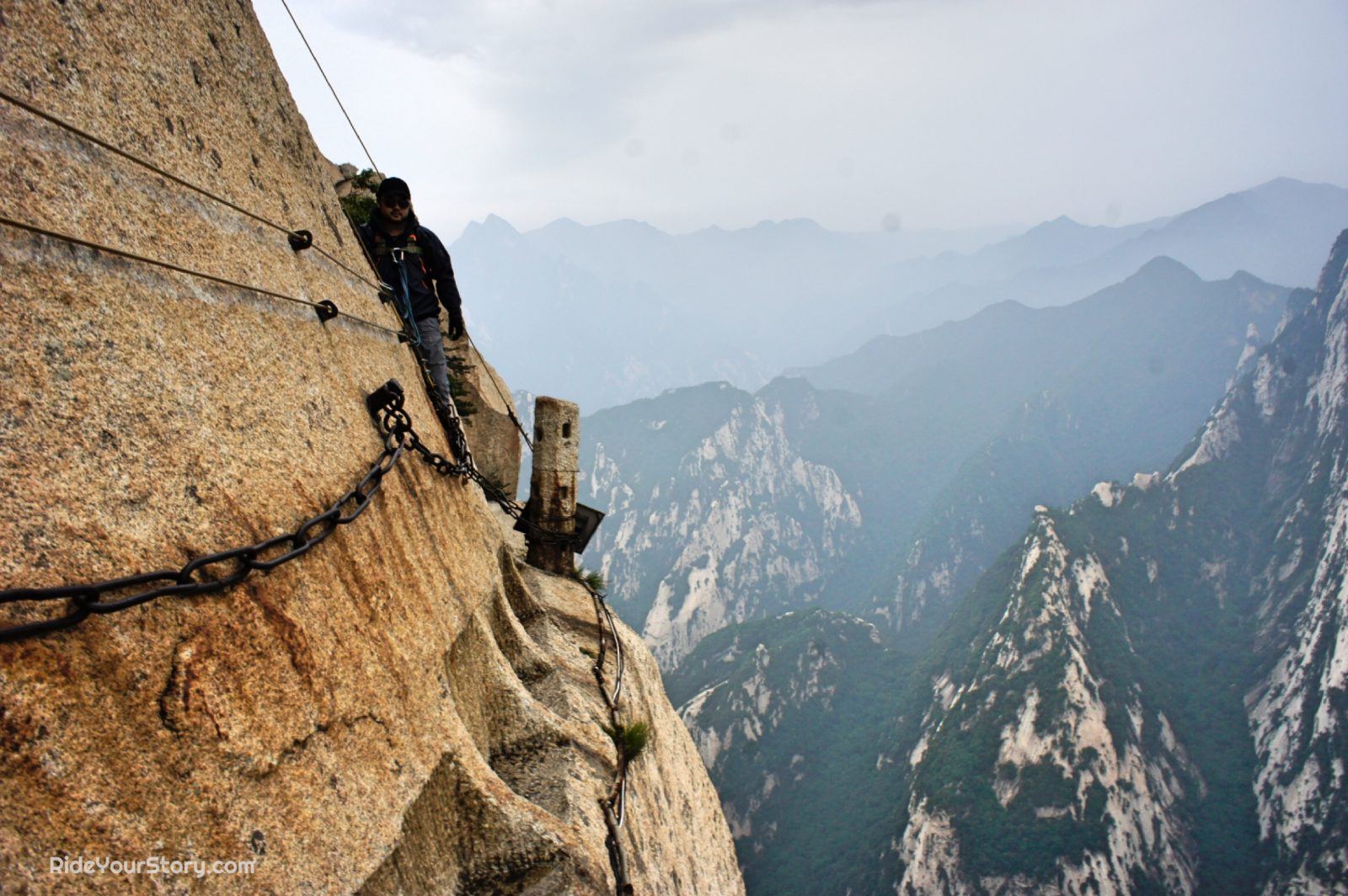
So How Dangerous is it ?
If you have acrophobia or height vertigo. You can skip this section as it will just be a swaggering section to you. Otherwise, please read on…
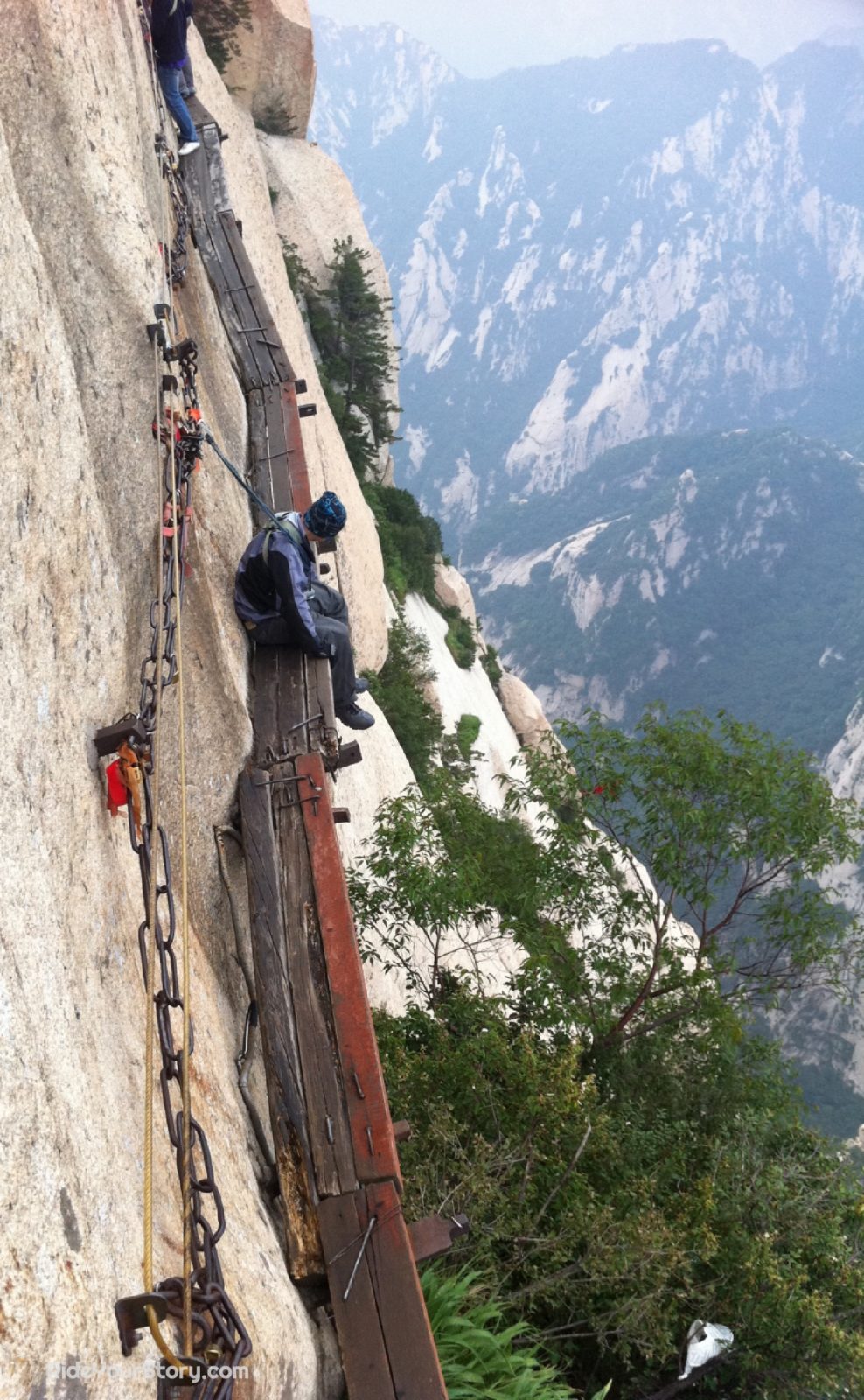
To keep it short : It caused less fear and anxiety than looking down from a 6th story glass railings in a shopping mall. All around you are picturesque view of the landscape and mountain, with no man-made structure, roads at the bottom (if you can see the bottom at all). Without it, there is no reference to scale, you lost the perception of height and your fear will be taken over. You will overcome the height and enjoy the walk in the park! Only if i can say the same for one of our acrophobic friend who is leg-shivering for us and hide himself somewhere far away from the starting point awaiting and praying for our safe return.
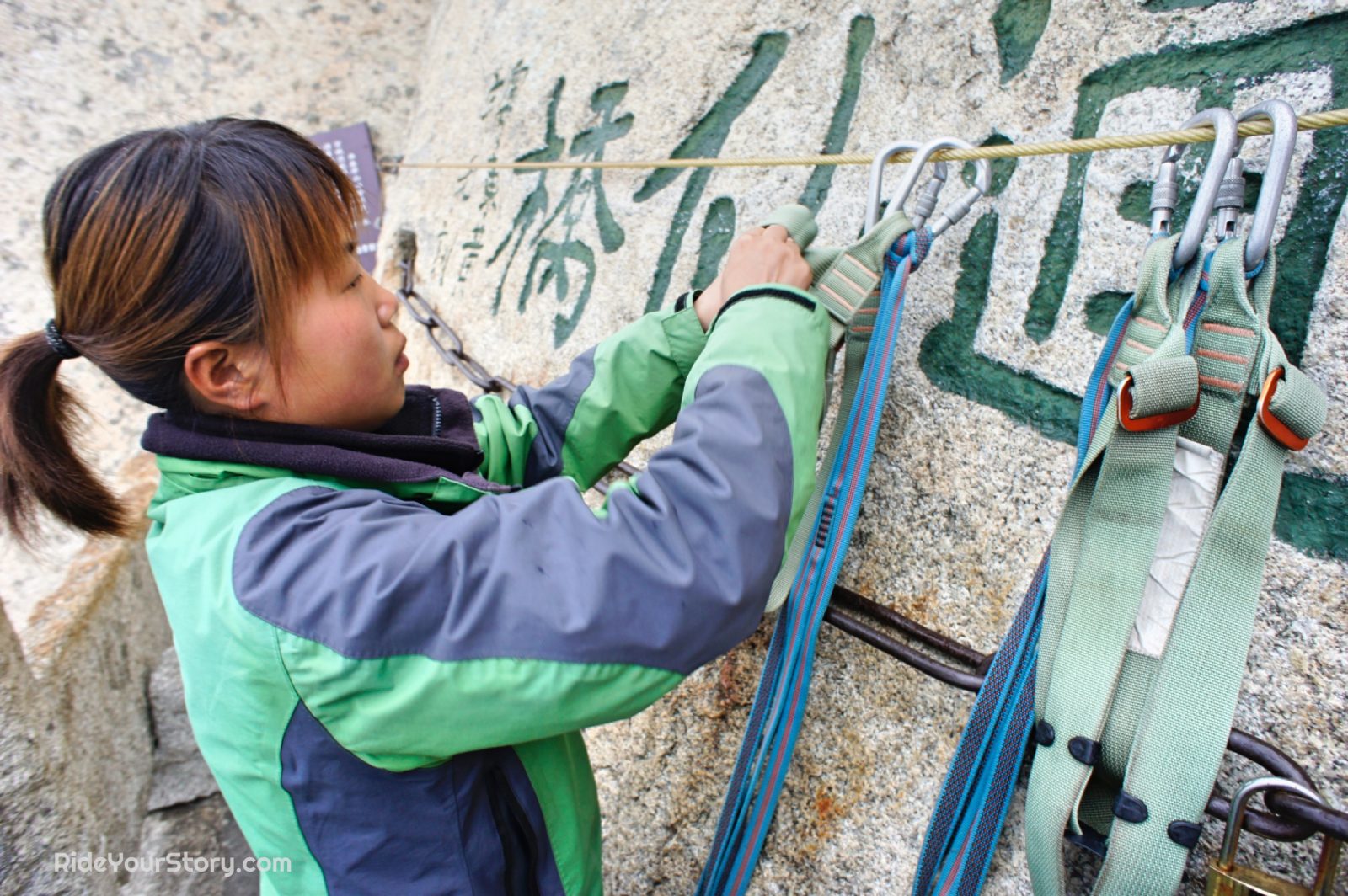
Safety harness are required for this walk, as long as you are mindful of the sequence to swap the carabiner along the walk. Especially if you have to overtake or be overtaken by the incoming hiker, on that three plank width. And I can recall correctly, there is a minimum age and height requirement, obviously you need to be able to reach the chain to secure your caribiner. Weight and waist size – if you are a plus size hiker and you made it this far to the top. This is an achievement in itself and there is no need to further claim your triumph with gravity and no place challenge yourself horizontally. This is not your fight. Beside, their overused safety equipment, standard and record are a questionable concern.

The plank walk is not a long hike. and is less than 100m (or 50+m depending on your source of reference). But it is the highlight of the trip to Huashan. But why is it proclaimed as the ‘most dangerous hike in the world’ on the internet, similarly to other ‘most dangerous’ hike you can find elsewhere. This plank walk is optional, and chargeable, it is not a mandatory hiking path. But this is most pictured and represented among the hiking path in Huashan,. Obviously it gives the more dramatic wow factor. You have many other option to scale Mount Hua, the easiest and most popular is with the cable car. The more dangerous hiking path are in fact the other route on the way up (or down!) which I will detail in the next post [placeholder].
The more thrilling part of the walk is not on the plank but the chiseled steps on the rock. Which i hope is the work of Hè Zhìzhēn where he took his steps. But close examination of the rock surface suggest otherwise. The cut are too clean and surface are new to be 800 years old (by now). There are other weathered and unused worn out holes, likely for some supporting beam or even hand grab or steps, found throughout the route. Being a seasoned stone mason and the only user of the meditation cave then. It won’t be a surprise he didn’t need any of the wooden planks at all. These are perhaps added later to cater for the thrill seeking tourist. The ‘Jacob’s Ladder‘ (not an official name, I made that up!) at the starting pointing, with the stainless steel steps are obviously added recently.
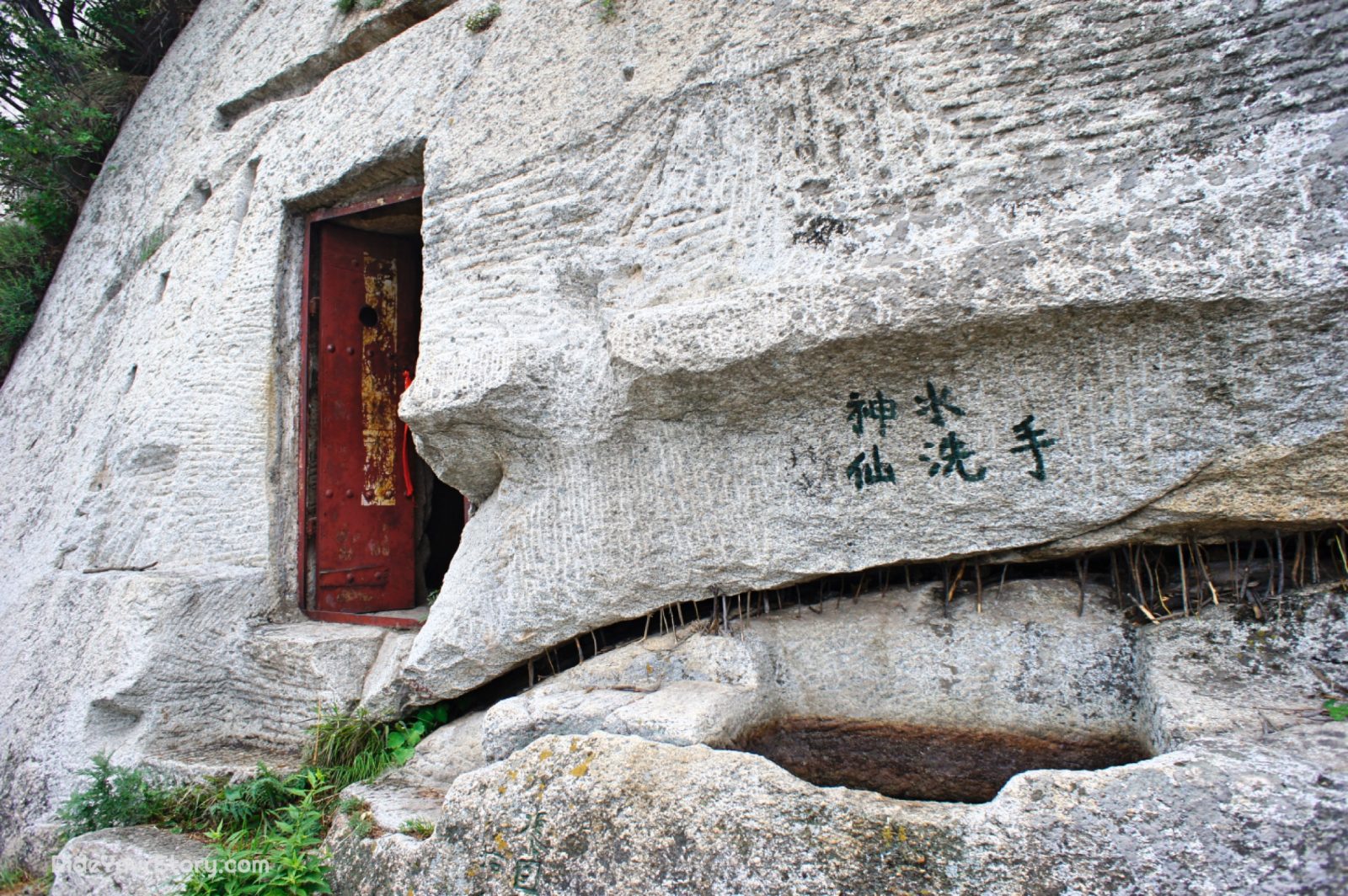
At the end of the walk, you will reached the meditation cave. This is the place of seclusion. The only way back to the worldly distraction is to turn around and take the same route. I have to say he really found a good spot, with a flat surface just in front of the cave, which likely was built by him, he might have use it for his vegetable garden. There could be water source within reach. Pictured above is a well but was empty. The word ‘神仙水洗手’ , loosely translated as ‘Immortal Water for hand washing‘. It must be the work of that same caretaker, definitely not from the immortal mason himself.
And here I am finally. I made the same journey of the old lady I saw in an old black & white documentary film, making her pilgrimage to this very spot to pay her homage to the saint. But she did it without the harness, just faith and belief. And If i can vaguely recall, there wasn’t even a plank to walk on. Yes it was a very old film footage, which I have yet to retrieve from the vast cyberspace archive. One more mission to go…
References :
- 不要轻易体验华山长空栈道,一位华山老员工以他多年经验诚恳警告
- 华山派
- 贺志真
- 华山长空栈道
- The roles of altitude and fear in the perception of height
- A Visit to Hua-shan
- Hua Shan – Historical photographs
- Selfie-taking tourist falls to her death from Huashan in northwest China
- This Chinese snow sweeper defies death daily to keep Huashan mountain tourist trail open
- Mount Huashan death suspected suicide
